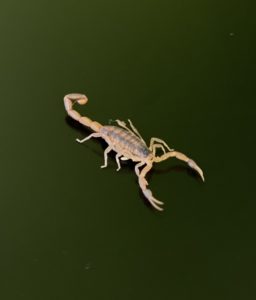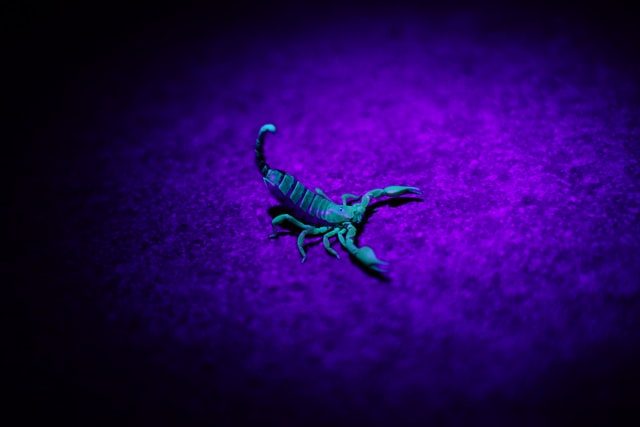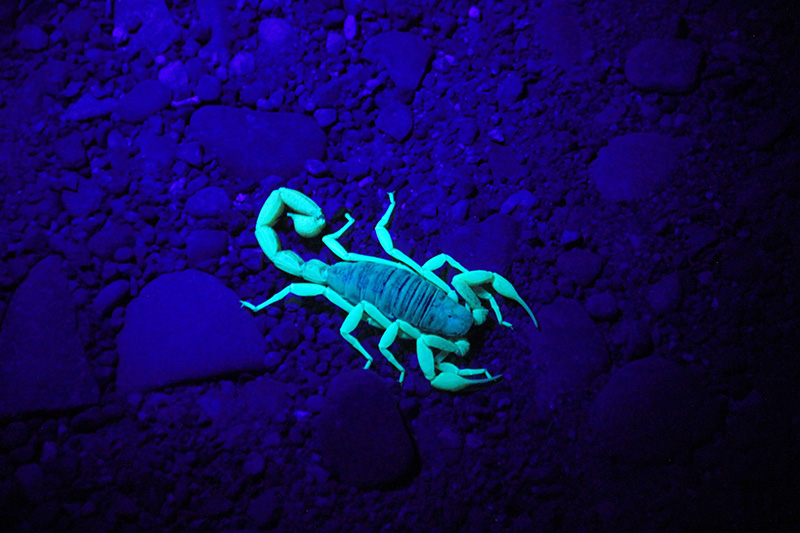With its warm, dry climate, Texas provides ideal conditions for arachnids. When we think of arachnids, most people tend to think of spiders or even ticks, but scorpions also belong to this classification. If you’re in Texas and see a scorpion, chances are it’s the striped bark scorpion. This particular scorpion happens to be quite fond of central Texas, as its rocky terrain gives the species plenty of shelter from the hot sun.
What does a striped bark scorpion look like?
 The striped bark scorpion is a medium-sized arachnid, measuring about 2 ¼ to 2 ½ inches. Like all arachnids, it has eight legs. Other identifying features include two long, brown vertical stripes down its body, a slender tail, and a triangular mark on the front of its head. Males tend to have longer tails than their female counterparts. While their colors range from brown to pale yellow, the depth of the colors will vary depending on the environment. Make no mistake, these colors are intentional and provide an effective camouflage for striped bark scorpions in their natural habitat. You may not see them very often during the day as they tend to come out at night when it’s cooler. But here’s something you may not know: striped bark scorpions can glow! So keep your black light close, and you just may spot one.
The striped bark scorpion is a medium-sized arachnid, measuring about 2 ¼ to 2 ½ inches. Like all arachnids, it has eight legs. Other identifying features include two long, brown vertical stripes down its body, a slender tail, and a triangular mark on the front of its head. Males tend to have longer tails than their female counterparts. While their colors range from brown to pale yellow, the depth of the colors will vary depending on the environment. Make no mistake, these colors are intentional and provide an effective camouflage for striped bark scorpions in their natural habitat. You may not see them very often during the day as they tend to come out at night when it’s cooler. But here’s something you may not know: striped bark scorpions can glow! So keep your black light close, and you just may spot one.
Why Do Striped Bark Scorpions Glow?

Many types of scorpions glow a bluish-green hue, including the Texas striped bark scorpion. This glow is the byproduct of their chemical makeup and is most visible once the scorpions shed or molt the outer layer of their skin. Striped bark scorpions produce this fluorescent light because their bodies pick up UV light and convert it to blue-green wavelengths, much like their eyes. Some researchers think this chemical reaction gives them the ability to sense the environment around them. So, by glowing, scorpions essentially turn their bodies into a second “eye.” Research into this is ongoing, but it seems to help them navigate, protect, and identify other scorpions. We humans can undoubtedly appreciate them shedding light on their whereabouts!
Are Striped Bark Scorpions Dangerous?
Striped bark scorpions can sting! The striped bark scorpion is one of the most venomous species of scorpion found in Texas. They secrete a neurotoxic venom that can make humans highly uncomfortable, thanks to the swelling, inflammation, and pain it causes. Thousands of people are stung each year when walking around barefoot or while rooting through piles of rocks or wood while not wearing gloves. The pain and discomfort from the sting will last for several days, though. You can treat a striped bark scorpion sting by icing the wound first, then following up with over-the-counter pain relief options. When in doubt, always seek medical attention.
Can striped bark scorpions live inside?
Again, the answer is yes. One of the primary skills of the striped bark scorpion is climbing, which is why people often find them in their attics. However, they tend to seek out cool spots, so be wary of picking up large rocks and piles of wood debris. As mentioned earlier, they tend to like the rocky area of central Texas, but they also live in the pine forests of eastern Texas. Additionally, they are relatively populous in Arizona and Mississippi but do call many other southeastern states home. It is sporadic to see one in an urban area, but they can hitch a ride from time to time. So, if you live in the city, you have much less chance of coming across one, but it’s not impossible.
Remember, scorpions are nocturnal creatures, as they are susceptible to daylight and can quickly overheat. So if you live in Texas, especially central Texas, keep an eye out for the striped bark scorpion. Enjoy their glowing beauty from afar, if you please, but if you keep finding any kind of scorpion near or in your house, don’t hesitate to call the experts. 855Bugs is here to help keep you and your family safe.




